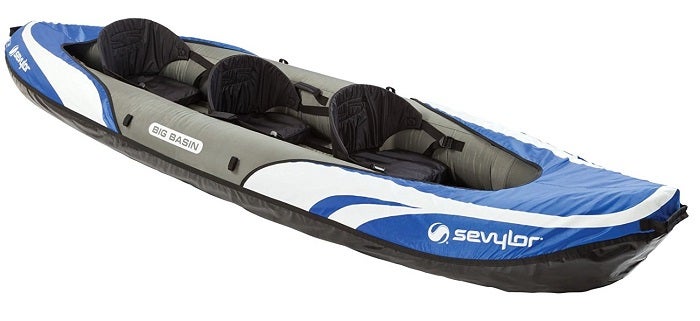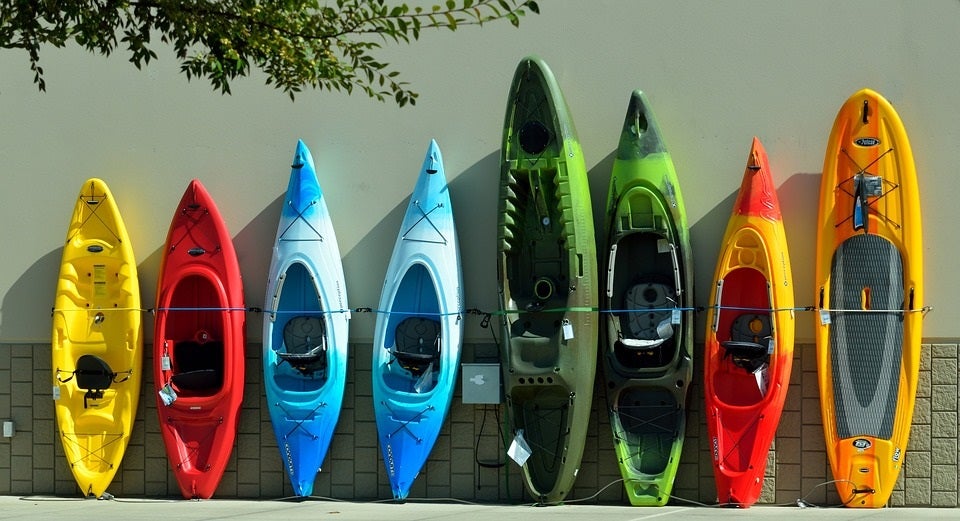
Our Editors independently research, test, and rate what we feel are the best products. We use affiliate links and may receive a small commission on purchases.
The following guide on How To Buy A Kayak will provide you with the information that you need to make an informed choice.
Regardless of how a person is introduced to the sport of kayaking, many people find it to be not only an extremely enjoyable sport, they also find that it is an excellent way to explore local ponds, lakes, marshes, swamps, estuaries, sounds, and seashores.
Kayaking is a full body/mind/soul experience that transports you from your everyday life of cell phones, Internet, traffic, and responsibilities to a world of Nature where you’re most important concern is simply enjoying what you see around.
The Different Types Of Kayaks
First of all, although there are numerous different types of kayaks, they all fall into one of two different categories which consist of sit-on-top kayaks and sit-inside kayaks.
Each of these categories is further divided into several sub-categories. Sit-on-top kayaks consist of such purpose specific designs as recreational, fishing, and surf kayaks whereas sit-inside kayaks consist of designs such as recreational, fishing, day touring, expedition, modular, skin-on-frame, and inflatable kayaks.

As the name implies, a sit-on-top kayak lacks an enclosed cockpit and instead has a cockpit that is completely exposed to the elements. Therefore, not only do they have a higher center of gravity, they also expose the paddler to the Sun, wind, and water when paddling.
In addition, due to their higher center of gravity, they are usually wider than sit-inside kayaks. However, many paddlers and especially beginners have a distinct preference for sit-on-top kayaks because they are easier to exit and reenter after a capsize. The sit on top is the most popular design for beginner kayaks.
Fishing Kayaks
Fishing kayaks can be either sit-on-top or sit-inside designs but, their defining difference is that they are specifically designed and outfitted from the manufacturer for fishing purposes.
Therefore, they feature such accoutrements as elaborate kayak seats, rod holders, standing platforms, center consoles, fish finder mounts, rod compartments, tank wells, and anchors.
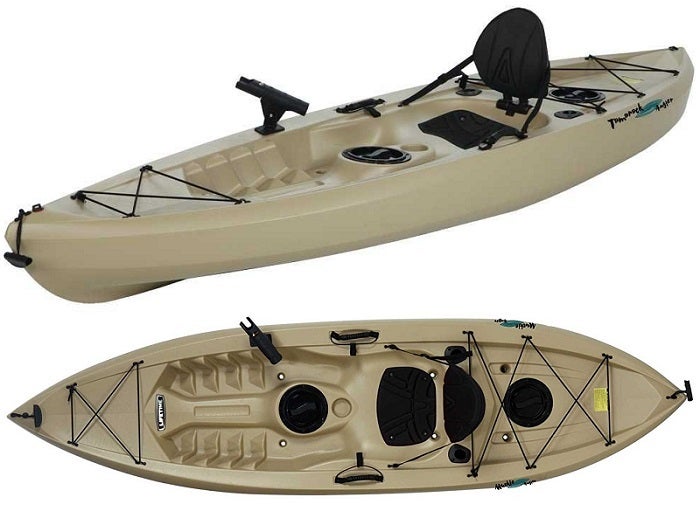
Recreational Kayaks
Like fishing kayaks, recreational kayaks can be either sit-on-top or sit-inside designs. Also, they have many characteristics in common with fishing kayaks in that they are defined by their relatively short length and relatively wide beam (the widest part of the hull) which purposely makes them both initially stable and highly maneuverable.
They are specifically meant for beginning and novice paddlers as well as young paddlers whose main interest is in simply gaining access to the water while making short, exploratory, excursions from their launch point. Here is a popular model:
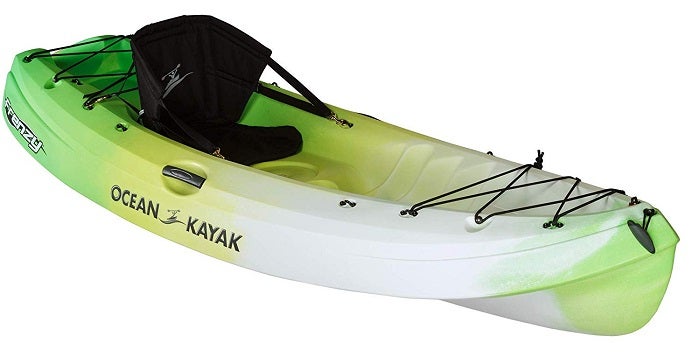
Tandem Kayaks
As the name implies, the tandem kayak is made for two people and can be either sit in or sit on top. They are made with all types of materials and for various uses, including fishing, recreation and touring.
They are ideal because not only can enjoy the water with a friend, it also has the added benefit of if one person gets tired the other can continue to paddle. They are most typically sit on top made from Thermoformed ABS. Here is a good example of popular model:
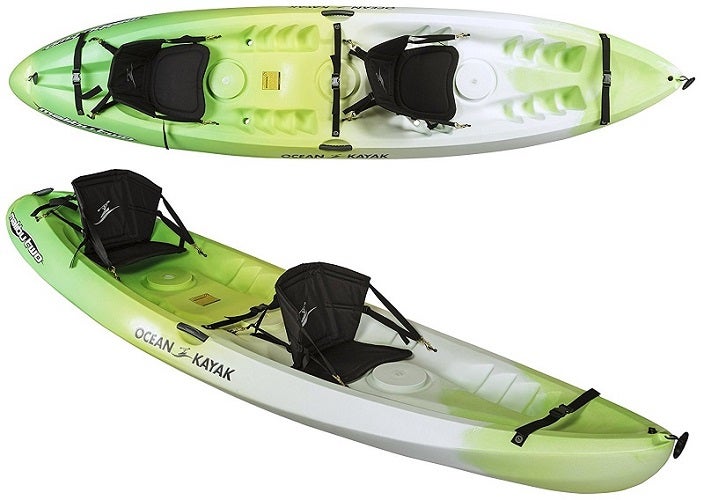
Touring Kayaks
Touring kayaks differ from recreational kayaks in that they are longer and slimmer than “rec boats” so that they have more efficient hull designs. Consequently, they are specifically designed for traveling over longer distances than recreational kayaks and for carrying light to heavy loads depending on the particular design.
Because they have significantly longer and slimmer hulls they also have less initial stability and less maneuverability than recreational kayaks do, so they require greater skill to keep from capsizing as well as greater skill to maneuver.
Furthermore, touring kayaks are available in three different sizes intended for three different purposes which consist of play boats, day touring kayaks, and expedition kayaks with play boats being the smallest and expedition kayaks being the largest.
As the name implies, “play boats” are either composite, plastic, or skin-on-fame touring kayaks with a high degree of rocker in their hulls that are specifically designed for playing in the surf, tidal rips, and/or rock gardens where a highly maneuverable and extremely responsive kayak is of paramount importance.
“Day Touring” kayaks are touring kayaks that are smaller in size than Expedition kayaks but are somewhat larger than Play Boats and are not as maneuverable due to a longer length and/or less rocker in their hulls.
Expedition kayaks are specifically designed for long distance travel and carrying heavy loads and therefore, they have extremely efficient hull designs with large “holds” and they are longer, wider, and higher in volume than day touring kayaks.
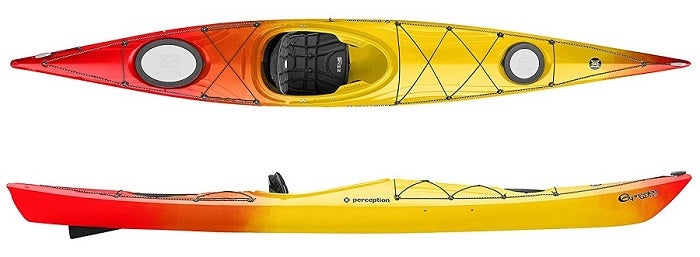
Modular Kayaks
Modular kayaks are either composite or plastic touring kayaks that disassemble into three, separate, pieces consisting of the bow section, the cockpit section, and the stern section.
They are specifically designed to accommodate the traveling paddler who has a preference for hard shell kayaks vs. folding kayaks due to significant differences in both feel and paddling performance.
Folding Kayaks
As you may have guessed from the name, modern folding kayaks are skin-on-fame touring kayaks that have a flexible wood or aluminum frame with nylon or Hypalon skins.
However, unlike their ancient cousins, modern folding kayaks have frames that are specifically designed to be easily disassembled and then reassembled.
Once disassembled, they usually fit into one or two medium sized duffle bags for easy transport and they can be easily reassembled once the paddler has arrived at their destination.
With the Oru folding kayak you can literally pull it out of the trunk of your car and be paddling in less than 5 minutes.
Inflatable Kayaks
Inflatable kayaks are kayak-shaped inflatable rafts that can easily be deflated for convenient transport and storage and then inflated prior to launching.
While their performance is not as good as the other types of kayaks they are by far the most portable and have become very popular in recent years. Here is our list of our recommended inflatable kayaks.
The Different Types Of Kayak Construction
A quick glance at a few of the various kayak manufacturers web sites will reveal that there is not only a wide range of kayak types, there is also a wide range of types of kayak construction.
For instance, the top-of-the-line production kayaks all feature composite construction with those made from rotomolded polyethylene plastic representing the low end of the scale and those made from thermo-molded ABS plastic falling somewhere in between.
Then, there are both stitch-and-glue and strip-built wood kayaks that can range from the most basic models to excessively expensive works of art. Last, there are both modern reproductions of ancient Inuit and Aleutian skin-on-frame kayaks and modern, folding, skin-on-frame kayaks as well.
Composite Kayaks
Composite kayak construction encompasses several different types of hard shell kayak construction such as fiberglass, e-glass, Kevlar, and Carbon. Thus, when constructing a composite kayak, the manufacturer uses one or more of the above mentioned fabrics which is then impregnated with one of two types of epoxy resin and is then coated with a protective coating known as “gel coat”.
Consequently, composite kayaks represent the Mercedes Benz’s of kayak construction because they are all individually hand made from scratch. There are two methods of composite kayak construction that yield two different quality products.
The standard production method consists of laying the various pieces of fabric into the mold and then using wooden rollers to impregnate the fabric with the epoxy resin and then distribute it evenly throughout the hull and deck and the second method involves the exact same process.
After the epoxy resin is distributed by hand, a specialized bag is then placed over the kayak’s hull or deck and then, all of the air is vacuumed out of the bag (known as vacuum bagging) which squeezes any excess resin out of the fabric to create a lighter and yet, stronger, kayak.
Last, composites can be molded into shapes that are impossible to achieve with either ABS or rotomolded polyethylene plastics and thus, composite kayaks can be designed with more efficient hulls that deliver more speed for less effort from the paddler; albeit at greater expense.
Thermoformed ABS Kayaks
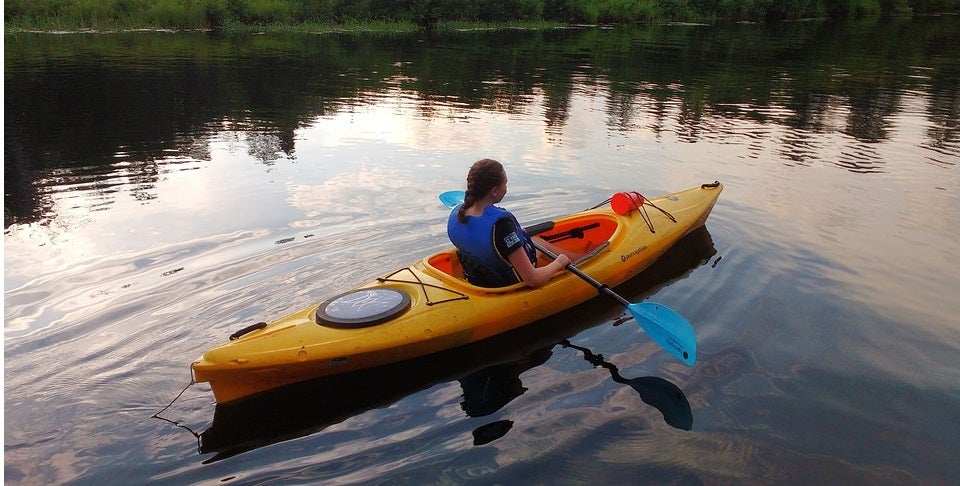
This type of kayak construction consists of sheets of acrylic laminated to sheets of ABS plastic which is then heated and thermoformed to create a laminated plastic construction with a glossy finish that is similar to composites in both appearance and performance but which costs significantly less.
Also, although kayaks made using this construction method are a bit heavier than composite kayaks, they are significantly lighter than polyethylene kayaks and are more resistant to abrasion and gouges than polyethylene is. Plus, if it does get a gouge, this type of plastic kayak construction is repairable.
Rotomolded Polyethylene Kayaks
Polyethylene is by far the most popular type of kayak construction for both recreational and sit-on-top kayaks because it is relatively inexpensive to manufacture and extremely tough. Polyethylene can be molded in a variety of manners; the most common of which is rotomolding (short for rotational molding).
In this process, plastic pellets are heated in a metal mold to their melting point and then, the heated mold is rotated to spread the liquid plastic evenly around the interior and then, the mold is allowed to cool slowly while still being rotated to form the finished kayak.
Polyethylene will degrade when exposed to ultraviolet light which causes it to become brittle and should be protected from sunlight exposure.
Three Types of Polyethylene
Linear: Linear polyethylene is the most common type of polyethylene used to make kayaks. Also known as single-layer polyethylene, it provides good performance at a reasonable price.
Super Linear: Super Linear polyethylene is a significantly lighter, tougher, stiffer, and more UV resistant form of polyethylene than Linear PE. Although it costs more, it makes significantly better, longer lasting, kayaks.
Cross-linked Polyethylene: Cross-linked polyethylene is a type of laminated kayak construction that consists of a closed-cell foam core sandwiched between two layers of linear polyethylene. While the two outer layers provide abrasion resistance, the foam core provides structural integrity, stiffness, and extra flotation.
Also, there is a newer version called “variable-layer polyethylene” which strategically distributes layers of the foam-core of varying thickness throughout the hull for improved efficiency.
Wood Kayaks
Wood kayaks are available in two different types consisting of cedar strip and stitch-and-glue construction. As the name implies, cedar-strip kayaks are made from thin strips of cedar placed edge to edge over a form and then glued together.
Then, the finished hull is then covered in fiberglass. Whereas, stitch-and-glue wood kayaks are made from sheets of marine grade plywood that have been cut to shape and then “stitched” together using small lengths of wire until the glue holding the seams dries.
The completed hull is also covered in a thin layer of fiberglass. Wood kayaks can range from utilitarian stitch-and-glue kayaks to elaborate cedar strip kayaks that are amazing demonstrations of the kayak builder’s art.
Because marine grade plywood is not particularly flexible, kayak designers are very limited in the shapes that they can create using stitch-and-glue construction whereas, cedar strips are far more flexible so more intricate shapes can be achieved using cedar strip construction.
On the other hand, stitch-and-glue kayaks require considerably less time, effort, and skill to build than cedar strip kayaks do and the materials are cheaper as well. As a comparison, stitch-and-glue kayaks are generally considered to be inexpensive economy cars while strip-built cedar kayaks are a Mercedes-Benz.
Skin-On-Frame Kayaks
Skin-on-frame kayaks are the earliest form of kayak technology and they consist of a lashed, wooden, frame covered by a “skin” consisting of oiled seal and/or walrus hide. However, modern reproductions can have skins made from painted cotton canvas, ballistic nylon, or a polyester fabric which is then sealed with a modern sealant.
In fact, there is a growing interest in this type of kayak among those who favor traditional paddling techniques and there are now several custom shops handcrafting this type of kayak to individual specifications.
Design Aspects Of A Kayak Hull
In addition to kayak construction, there are various design aspects of a kayak hull that should be taken into consideration before purchasing a kayak because they can drastically affect your experience.
For instance, hull shape, stability, maneuverability, and chine type are all interdependent and thus, changing one aspect, changes all of the others. Then, there is the matter of skegs and rudders which some paddlers love and others absolutely despise.
Hull Stability
When sitting in a kayak, there are two types of stability (the tendency to stay upright). The first type is a measure of how stable the kayak feels when you are sitting upright directly over the center of the boat in calm water and this type of stability is called “initial stability”.
Then, there is a second type of stability that you experience when you tip the kayak on its side which is called “secondary stability”. As a general rule, kayaks with a high degree of initial stability have a low degree of secondary stability and vice versa.
So most beginners prefer kayaks with a high degree of initial stability for paddling on calm water and most expert paddlers prefer a kayak with a high degree of secondary stability so that it is easier for them to lean the kayak on edge when turning and to remain upright in rough water.
Hull Shape
Kayak hulls are available in one of three different shapes consisting of Fish Form hulls, Symmetrical hulls, and Swede Form hulls and each has advantages and disadvantages. Fish Form hulls are defined by having the widest point of the hull located forward of the center of the hull and thus, they are the most stable of the three designs but, they are also the slowest.
Symmetrical kayak hulls are defined by having their widest point located in the exact center of the hull and they provide a compromise between speed and stability.
Swede Form kayak hulls have their widest point located before of the center of the hull and are the fastest of the three types of kayak hulls but they are also the least stable. Most beginners prefer Fish Form hulls, while most experts prefer either Symmetrical or Swede Form hulls.
Length vs. Width
Another important relationship that you should be aware of is the one between length and width because the faster a kayak is, the less effort it requires to paddle it. Short kayaks are slow and long kayaks are fast. Also as a general rule, wide kayaks are slower and narrow kayaks are faster.
Another general rule is wide kayaks have more initial stability than narrow kayaks while narrow kayaks have more secondary stability than wide kayaks. Last, short kayaks are more maneuverable than long kayaks but they are also slower while longer kayaks are faster but less maneuverable than shorter kayaks.
Consequently a short, wide kayak is the best choice for beginning paddlers who want to paddle short distances on calm water and long, slim, kayaks are the best choice for advanced paddlers who want to paddle over extended distances on both calm and rough seas.
Maneuverability vs. Tracking
The last relationship that you need to be aware of is that of maneuverability versus tracking (the tendency of a kayak to travel in a straight line). If you were to look at several kayak’s hulls from the side, you would see that some have flat keels and others have highly curved keels while others are in between.
Therefore, this curvature or lack thereof is called “rocker” and the less rocker a kayak’s hull has, the better it “tracks” (travels in a straight line) but, the less maneuverable it will be. On the other hand, the more rocker a kayak’s hull has, the more maneuverable it will be but, the more difficult it will be to keep is going in a straight line.
Most beginners tend to prefer a more maneuverable kayak while experts tend to prefer a kayak that tracks well.
Hard Chines vs. Soft Chines
The chines of kayak’s hull are located at the point where the bottom transitions into the side. Kayaks with soft chines have smoothly rounded hulls whereas, kayaks with hard chines have a distinct angle in the hull.
The reason that this is important is that kayaks with soft chines feel entirely different from kayaks with hard chines. In fact, as a general rule, kayaks with soft chines have more initial stability but less secondary stability than kayaks with hard chines.
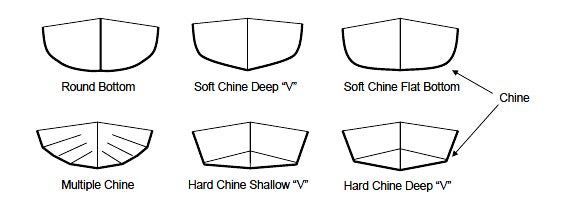
However, kayaks with hard chines have less initial stability and more secondary stability than kayaks with soft chines. Most paddlers prefer kayaks with soft chines while a growing number are coming to appreciate traditional kayak designs with hard chines.
Skegs vs. Rudders
A retractable skeg is a type of fin housed inside of the stern keel of a kayak. A rudder is like a skeg in that it has a metal blade that extends from the stern of the kayak into the water but a rudder is moveable from side to side and is controlled by sliding foot braces inside the kayak’s hull.
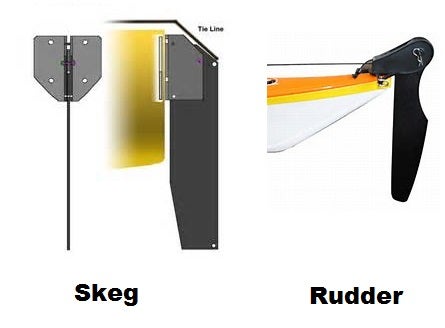
Both skegs and rudders are used to aid the kayak in traveling in a straight line and are most often used on kayaks with a high degree of rocker in their hulls. That way, kayak designers can create a kayak that is both highly maneuverable and which also tracks reasonably well.
How To Choose A Kayak
So, as you can see from the information listed above there are an overwhelming number of things to be considered if you are to purchase the best possible kayak design to meet your particular needs.
Therefore, in order to make the process easier, you should first break it down into three separate steps.
You should start by identifying the purpose for which you will most often be using the kayak and then chose the type of kayak that best suits that particular purpose.
Then, based upon your budget constraints and individual preferences, you should then choose the type of kayak construction that best suites you.
Once you have settled on a particular type of kayak and the type of kayak construction you prefer, then you can contemplate the various design aspects of each of the individual kayaks that you believe that you may find suitable.
Some general rules to keep in mind are: short, wide, kayaks such as Sit-on-Top and Recreational kayaks are most often preferred by beginners because they have a high degree of initial stability and are highly maneuverable but, they are not well suited for travel over long distances or for carrying loads.
On the other hand, long, slim kayaks such as Day Touring or Expedition kayaks are most often preferred by intermediate and advanced paddlers because they track well and are well suited for traveling over long distances and for carrying loads.
Also, wide kayaks feel the most stable on still water but are more prone to capsize in rough water than slim kayaks are whereas, slim kayaks feel the most stable when leaned on to their sides and thus, are better suited for paddling in rough water.
In addition, the faster a kayak is, the less effort it requires to paddle it and thus, short kayaks are slower, but more maneuverable, than long kayaks while, long kayaks are faster, but less maneuverable, than short kayaks.
Furthermore, kayaks with low volume are best suited for smaller, lighter paddlers while kayaks with high volumes are better suited for larger paddlers and/or extended trips.
So, if you are contemplating the purchase of a kayak in the near future use information listed above because the purchase of a kayak can be a significant investment.
So it is imperative that you purchase the correct one the first time because a mistake can not only be costly, it will seriously limit the amount of fun that you have with your kayak and how often you take it out.
If you need a guide on learning how to kayak, see my Beginners Guide on How to Kayak.

